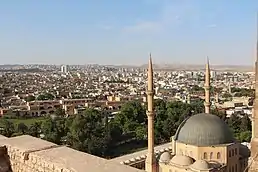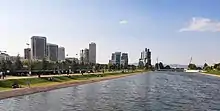Urfa
Urfa, officially known as Şanlıurfa (pronounced [ʃanˈɫɯɾfa]) and in ancient times as Edessa, is a city in southeastern Turkey and the capital of Şanlıurfa Province. Urfa is situated on a plain about 80 km east of the Euphrates River. Its climate features extremely hot, dry summers and cool, moist winters.
Urfa | |
|---|---|
Metropolitan municipality | |
| Şanlıurfa | |
Clockwise from top: View of Urfa, Urfa Castle, St. Peter and St. Paul Church, Arabi Mosque, Rizvaniye Mosque | |
| Nickname: City of Prophets[1] | |
 Urfa  Urfa | |
| Coordinates: 37°09′30″N 38°47′30″E | |
| Country | Turkey |
| Province | Şanlıurfa |
| Founded | 303/302 BC |
| Founded by | Seleucus I Nicator |
| Government | |
| • Mayor | Zeynel Abidin Beyazgül (AKP) |
| • Governor | Abdullah Erin |
| Area | |
| • District | 3,668.76 km2 (1,416.52 sq mi) |
| Elevation | 477 m (1,565 ft) |
| Population (2021) | |
| • Total | 586,733[3] |
| Time zone | UTC+3 (TRT) |
| Website | www.sanliurfa.bel.tr |
About 12 km (7 mi) northeast of the city is the famous Neolithic site of Göbekli Tepe, the world's oldest known temple, which was founded in the 10th millennium BC.[4] The area was part of a network of the first human settlements where the agricultural revolution took place. Because of its association with Jewish, Christian, and Islamic history, and a legend according to which it was the hometown of Abraham, Urfa is nicknamed the "City of Prophets."[1]
Religion is important in Urfa. The city "has become a center of fundamentalist Islamic beliefs"[5]: 620 and "is considered one of the most devoutly religious cities in Turkey".[6]
The city is located 30 miles from the Atatürk Dam, at the heart of the Southeast Anatolia Project, which draws thousands of job-seeking rural villagers to the city every year.[6] As a result, many of Urfa's residents are very poor - according to municipal data, over 50% of the city's population lives below the poverty line, earning less than $100 per family per month.[6]
Name
The oldest name for the city is the Syriac Orhay, which is derived from either the Semitic root -r-w-ʿ, meaning "to bring water", or the Greek name name "Orrha", meaning "beautiful flowing water".[7]: 136
In earlier times, the city was known as Ruha, and with the Arabic article, it became Ar-Ruha, evolving into Urha, and eventually Urfa. Carsten Niebuhr observed that Turks called the city El-Rohha in the 18th century, although James Silk Buckingham, who later visited Urfa, disagreed and noted that all Turks, and most Arabs and Kurds in the surrounding countryside called it Urfa, while a small portion of the Christians called it as the former.[8] The city is called Riha in Kurdish.[9]
Geography
Urfa is located at the border between the foothills of the Taurus Mountains and the great Mesopotamian plain.[10]: 1 In general, these two regions meet "well to the south" of Urfa, but around Harran the plain extends northward, cutting into the hills.[10]: 1 At the northwestern corner of the Harran plain, there is another extension in the plain, this time going westward.[10]: 1 Urfa is located in this second extension of the plains, tucked behind the hills at its southern edge.[10]: 1
A small stream flows through Urfa.[10]: 2 This stream is known as the Daisan, or "leaping river", after its tendency for flooding.[7]: 136 Today, the Daisan flows through a man-made channel that follows the north and east sides of the old walled city.[10]: 2 Before the channel was made, though, the stream's natural course was on the west side of the old city, then it turned east.[10]: 2 Part of the former course survives as the fish pool called Birket Ibrahim, which tradition associates with the prophet Abraham.[10]: 3, 6 To the south of the stream's old course is a spring in a cave that is now converted into a mosque.[10]: 3
Since the 20th century, Urfa has expanded northward, across the little plain and the hill known as Şehitlik Mahallesi with blocks of flats, as well as over the escarpment to the south.[10]: 8
History
Urfa was founded as a city under the name Edessa by the Seleucid king Seleucus I Nicator in 303 or 302 BC.[11][12] There is no written evidence for earlier settlement at the site, but Urfa's favorable commercial and geographical placement suggests that there was a smaller settlement present prior to 303 BC. The indigenous Aramaic name for the site prior to the Seleucid period was Orhai or Orhay, which survives as the basis of the city's modern Turkish name.[11] Perhaps Orhai's absence from earlier written sources is due to the settlement having been small and unfortified prior to the Seleucid period.[13] Seleucus named the city after the ancient capital of Macedonia.
Prehistory
.jpg.webp)
Urfa shares the Balikh River Valley region with two other significant Neolithic sites at Nevalı Çori and Göbekli Tepe. Settlements in the area originated around 9000 BC as a PPNA Neolithic sites located near Abraham's Pool (Site Name: Balıklıgöl). They were part of a network of first settlements spanning West Asia where agriculture began. The life-sized limestone "Urfa Man" statue was found at Urfa during an excavation and is now on display at the Şanlıurfa Archaeology and Mosaic Museum.[15] The Urfa Man resembles both carvings at nearby Gobekli Tepe and statues found at 'Ain Ghazal. The village at Balıklıgöl was followed by a string of four PPNB villages on four hilltops at the Gürcütepe site. Beginning in 6200 BC small Halaf culture villages began to appear in the Balikh Valley. The typical Halaf village is 2ha with a population of 500 people surrounded by agricultural fields. By 5000 BC the entire valley was densely filled.
The region was conquered repeatedly throughout history, and has been dominated by many civilizations, including the Ebla, Akkadians, Sumerians, Babylonians, Hittites, Hurri-Mitannis, Assyrians, Medes, Persians, Ancient Greeks (under Alexander the Great), Seleucids, Armenians, Arameans, the Neo-Assyrian Osrhoenes, Romans, Sassanids, Byzantines, Arabs, Seljuqs and Ottomans.
City of Edessa
In the late 2nd century, as the Seleucid dynasty disintegrated, it became the capital of the Arab Nabataean Abgar dynasty, which was successively Parthian, Aramean/Syriac kingdom Osroene, Armenian, and Roman client state and eventually a Roman province. Its location on the eastern frontier of the Empire meant it was frequently conquered during periods when the Byzantine central government was weak, and for centuries, it was alternately conquered by Arab, Byzantine, Armenian, Turkish rulers. In 1098, the Crusader Baldwin of Boulogne induced the final Armenian ruler to adopt him and then seized power, establishing the first Crusader State known as the County of Edessa and imposing Latin Christianity on the Greek Orthodox, Assyrian Church of the East and Armenian Apostolic majority of the population.
Ancient sources describe Seleucid Edessa as following the typical plan for Hellenistic military colonies: its streets were laid out in a grid pattern, with four main streets that intersected each other.[16]: 89 There were four city gates, and the main citadel was outside the walls.[16]: 89 Macedonian soldiers were settled in the new city,[16]: 89 but they never formed a majority of its population.[17] The city's culture remained predominantly Semitic (specifically Aramaic), and any Hellenization was minimal.[16]: 89, 91–2
Edessa was an important commercial center in the 3rd and 2nd centuries BCE.[10]: 198 Previously, the main east-west trade route across Upper Mesopotamia had gone through Harran, but the founding of Edessa caused that route to shift northwards.[10]: 195
The Seleucids declined in the 2nd century BCE, and Edessa became the capital of the Abgarid kingdom of Osrhoene in about 132 BCE.[16]: 89 Originally from Nisibis, the Abgarids appear to have been an Arabized dynasty and may have ruled their kingdom "much as Arab shaikhs, through a council of tribal elders".[16]: 89–90 The Abgarids were generally allied with the Parthian Empire and were under Parthian cultural influence as well.[17]
In the early second century CE, however, the Abgarids came under Roman influence.[16]: 90 Abgar VII supported the Roman emperor Trajan's campaign in Mesopotamia and received him "sumptously" at his court, but later rebelled.[16]: 90 In retaliation, the Romans captured and destroyed Edessa, and Abgar VII was killed.[16]: 90 The Romans installed a Parthian prince, Parthamaspates, on the Edessan throne as a puppet ruler in 117, but the Abgarids were later restored to power.[16]: 90 Similarly, the Parthians captured Edessa in 163 and installed Wa'el bar Sharu as a puppet king.[16]: 90 The deposed Ma'nu VIII went to the Romans, who took Edessa in 165 and restored Ma'nu to power.[16]: 90 In 166, Osrhoene became a Roman client kingdom.[16]: 90
Ma'nu VIII died in 177 and was succeeded by Abgar VIII, also called Abgar the Great.[16]: 90 Abgar sided with Pescennius Niger in his civil war against Septimius Severus.[16]: 90 Severus ended up winning that conflict and, as punishment, stripped Abgar of most of his kingdom.[16]: 90 Osrhoene now became a Roman province, while Abgar himself was left to rule just Edessa.[16]: 90 Abgar mostly retired from international politics and spent the rest of his reign as "one of the Near East's greatest patrons of the arts and learning".[16]: 91
In 201, much of Edessa was destroyed by a major flood.[16]: 91 According to the Chronicle of Edessa, over 2,000 people died.[16]: 91 Abgar granted a remission of taxes for all who were affected by the flood and immediately began a large-scale reconstruction project of the city after the old Seleucid plan.[16]: 91 Abgar repaired the old royal palace by the river, which had been damaged by the flood, but he also built a new palace on higher ground.[16]: 91
Ancient Edessa's diverse religious background

Ancient Edessa was an eclectic melting pot of different religious groups.[16]: 92 Unlike Harran, where the cult of the moon god Sin predominated, the people of Edessa worshipped a whole pantheon of gods that can generally be identified with planets.[10]: 195 The most important were Nabu and Bel.[16]: 92 The cult of the sun and moon that was later known in Harran as the Sabians also had followers in Edessa.[16]: 92 The fertility goddess Atargatis, whose cult was based at Manbij, was also worshipped in Edessa.[16]: 92 Fish were an important symbol of Atargatis, and in ancient Edessa there was a fish pond filled with sacred carp dedicated to Atargatis – today's Balıklıgöl.[18]: 79–80 Other gods worshipped in pagan Edessa included the Nabataean deity Dushara, the Mesopotamian goddess Ishtar, and also the moon god Sin.[16]: 93 Another important cult at Edessa involved the veneration of a virgin mother and her child.[16]: 93
In addition to polytheists, Edessa also had a prominent Jewish community.[16]: 93 Many of Edessa's Jews were merchants, involved in long-distance trade between the Persian Gulf and the Mediterranean.[16]: 94
By the end of the 2nd century, a small Christian community had appeared in Edessa.[10]: 195 The city's cosmpolitan religious background meant that its people were open and accepting towards this new religion, which just added another element into the mix.[16]: 95 Christianity also resonated with several religious themes already present in Edessa - besides the concept of a virgin mother and child, there was also the concept of a divine trinity and a hope for life after death.[16]: 95 The people of Edessa were also familiar with monotheism, through exposure to Judaism, and Edessa's Jewish community was probably partly responsible for the rapid spread of Christianity in the city.[16]: 94–5 Abgar the Great reportedly converted to Christianity around the turn of the 3rd century, which if true would make Edessa the first Christian polity in the world.[16]: 95
Still more religions joined the mix during the 3rd century.[16]: 95 One was the Bardaisanites, founded by the important philosopher Bardaisan who Abgar the Great was a patron of.[16]: 94 Another was the Elkesaites, a syncretic religion that combined elements of Christianity, Judaism, and paganism.[16]: 96 Its founder, Elkesai, claimed to be a reincarnation of Jesus, and the Elkesaite belief in reincarnation is possibly a sign of Buddhist influence.[16]: 96 The prophet Mani was an Elkesaite before founding Manichaeism - another syncretic religion that "found ready ground in Edessa".[16]: 96 There was already an active Manichaean community in Edessa during Mani's lifetime: there is a reference in the Cologne Mani Codex to a letter he wrote to his followers in Edessa.[17] Manichaeism's spread to Edessa was attributed to two of Mani's disciples named Addai and Thomas.[16]: 95 Edessa's Manichaean community remained prominent until the 5th century.[16]: 95
Edessa during late antiquity
In the 4th through 6th centuries, Edessa went through arguably its period of greatest prosperity.[10]: 198 It was again an important commercial center, and merchants grew rich on trade in luxury goods from the east, particularly silk.[10]: 198 As with later periods, the city had a council of notable citizens who were at least partly in charge of local government and administration.[10]: 198 In the 5th century there were three different theological schools in Edessa: the School of the Syrians (affiliated with the patriarchate of Antioch), the School of the Armenians, and the famous School of the Persians (whose teachers were not actually Persians but rather members of the Church of the East).[10]: 198 The School of the Persians was closed down in 489 and its staff relocated to Nisibis.[10]: 198 There were many churches in the city and monasteries in the area.[10]: 198 Just outside the walls were several infirmaries and hospitals.[10]: 198
By the early 6th century, a small lake had formed on the west side of the city.[10]: 3 In 525, a flood destroyed part of the western city wall and damaged some of the city.[10]: 3 Afterwards, a deep ditch was dug on the north and east sides of the city to act as a flood channel.[10]: 3 In normal weather, a low dam kept the Daisan river in its original course, but if the dam overflowed, then the floodwaters would flow through the artificial channel instead of into the city.[10]: 3 At some point later on, the flood channel has become the normal course of the river.[10]: 3
Age of Islam
Urfa surrendered to the Rashidun general Iyad ibn Ghanm in 639 without resistance, supposedly when Iyad "stood at its gate riding a brown horse" according to al-Baladhuri.[19]: 46 Several versions of the terms of surrender appear in historical sources, mentioning the citizens would be responsible for "repairing 'bridges and roads'".[19]: 46
In the early centuries of Arab rule, and particularly under the Umayyads, Urfa was still a major Christian city.[10]: 201 It formed part of the province of Diyar Mudar.[20]: 589 The city reportedly had 300 or 360 churches, and there were many monasteries.[10]: 201 The population was mostly Syrian Orthodox but with significant Melkite and Jewish minorities; there were relatively few Muslims.[10]: 201 The city was led by a group of distinguished citizens, including magnates and agricultural landowners, who "formed a partly self-governing body" that dealt with the caliphal government rather than the bishop.[10]: 3, 201 Some of the leading families in this period included the Gūmāyē, the Telmaḥrāyē, and the Ruṣāfāyē.[20]: 589

During the reign of the Abbasid caliph al-Mansur, the city walls were demolished after the local Muslim governor revolted.[10]: 3 The old walls had already been damaged by floods in the 7th and 8th centuries.[19]: 11 In 812, Urfa's citizens had to pay a large sum to the anti-Abbasid rebel Nasr ibn Shabath al-Uqayli to prevent him from attacking the unprotected city.[20]: 589 Afterwards, the citizens had new defensive walls built around the city.[10]: 3 According to Bar Hebraeus, the walls were commissioned by someone named Abu Shaykh and paid for by the citizens.[20]: 589–90 The walls and towers visible today belong to this rebuilding effort, albeit with later renovations.[10]: 3 The citadel was likely begun at the same time, probably with the addition of a moat on the south side.[10]: 6
In the spring of 943, the Byzantine army campaigned in upper Mesopotamia, capturing several cities and either threatening Urfa or, according to Symeon Magister, besieging it outright.[19]: 19 The Byzantines that the mandylion (called al-mandīl in Arabic), by now a famous Christian relic, be handed over to the emperor.[19]: 46 In return, the city would be spared and 200 Muslim prisoners would be released.[19]: 46 [20]: 589 With permission from the caliph al-Muttaqi, the people of Edessa handed over the mandylion and signed a truce with the Byzantines.[19]: 46 [20]: 589 The mandylion was translated to Constantinople; it arrived "triumphantly" on 15 August 944.[19]: 19
11th century
The Numayrid emir Waththab ibn Sabiq declared independence in 990 and annexed Edessa early in his reign.[10]: 204 Waththab appointed his cousin 'Utayr as governor of the city.[10]: 204 'Utayr installed someone named Ahmad ibn Muhammad as his na'ib (deputy) here, but then later had him assassinated.[20]: 590 This evidently made 'Utayr unpopular with the locals, since Ahmad had treated them well.[10]: 204 In 1025/6 (416 AH), the city's inhabitants rebelled and appealed to Nasr ad-Dawla, the Marwanid emir of Diyar Bakr.[20]: 590 [10]: 204 At first, Nasr ad-Dawla appointed someone named Zangi to be his deputy in Edessa, but Zangi died in 1027.[20]: 590 Meanwhile, 'Utayr had been assassinated.[20]: 590 This time, Nasr ad-Dawla ended up appointing two deputies to jointly control Edessa: he chose 'Utayr's son, known only by the nasab "Ibn 'Utayr", to be in charge of the main citadel, while he appointed a different Numayrid named Shibl ad-Dawla to be in charge of the smaller citadel - i.e. the converted east gate, now the Bey Kapısı.[10]: 204

In October 1031, the Byzantine general George Maniakes conquered Edessa.[19]: 20 This would ultimately be the last significant territorial acquisition by the Byzantine Empire in Mesopotamia.[19]: 20 The accounts of this event differ heavily.[20]: 590 According to one version, Ibn 'Utayr had entered into negotiations with Maniakes, intending to sell him the citadel.[10]: 204 His desire to sell was apparently motivated by a threat from Shibl ad-Dawla.[10]: 204 In John Skylitzes's version, however, Maniakes had bribed Salman, a deputy of Nasr ad-Dawla's, into surrendering the city to him in the middle of the night.[19]: 20 If this was the case, then Salman either had some authority over Ibn 'Utayr or had otherwise deposed him.[10]: 204
Whoever Maniakes had been negotiating with, Byzantine forces gained control of some of the fortifications but not the rest of the city.[10]: 204 Exactly which parts Maniakes had taken control of are unclear - Skylitzes described Maniakes had taken possession of "three heavily fortified towers", but his description of Edessa's geography is completely inaccurate and he clearly had never been to the city himself.[19]: 20 Matthew of Edessa's account, which is more reliable, mentions "three citadels"; according to Tara Andrews, the upper citadel must have been one of them.[19]: 20 According to T.A. Sinclair, Maniakes had already gained control of the upper citadel.[10]: 204 That winter, Nasr ad-Dawla came with an army in an attempt to drive out the Byzantines.[20]: 590 Nasr ad-Dawla tried to besiege the Byzantine positions but was unsuccessful and decided to loot the city and tear down buildings, then burn the city to the ground while retreating with camels carrying off precious objects.[19]: 20 According to Skylitzes, Maniakes was able to then capture the citadel and, summoning external reinforcements, secure the whole city.[19]: 20
Maniakes remained in charge of Edessa for several years and, according to Honigmann and Bosworth, appears to have been relatively autonomous from the Byzantines, merely sending an annual tribute to Constantinople.[20]: 590 On the other hand, while Skylitzes does mention that "Maniakes sent an annual tribute of 50 pounds [of gold] to the emperor", Niccolò Zorzi remarks that this "does not necessarily imply that Edessa 'enjoyed a certain amount of independence from Byzantium'".[19]: 21 The citadel became known as "Maniakes's citadel" at some point.[19]: 21
In May 1036, the Numayri prince Ibn Waththab plundered the city and took the patricius of Edessa as prisoner, but the fortress remained in the hands of the Byzantine garrison.[20]: 590 A peace treaty was reached in 1037; under its terms, Edessa came directly under Byzantine control and it was refortified.[20]: 590 Edessa now became an important Byzantine command placed under a series of katepanos and dukes.[10]: 204 The "duchy" of Edessa probably comprised the whole area beyond the Euphrates under their control with several fortresses north of the river.[19]: 20 The city "was still inhabited by many Christians" at this point.[20]: 590
In 1065-6 and 1066-7, the city was attacked by the Turkish leader Khurasan-Salar.[20]: 590 For 50 days beginning on 10 March 1071, Urfa was besieged by the Seljuk sultan Alp Arslan.[19]: 23 Alp Arslan eventually lifted the siege in return for a large payment and possibly also the submission of its ruler, the doux Basilios Alousianos (son of Alusian of Bulgaria).[19]: 23 After the Battle of Manzikert, Edessa was intended to be handed over to the Seljuks, but the Byzantine emperor Romanos Diogenes was deposed and in the political chaos its katepano Paulus ended up siding with the new emperor.[20]: 590
In 1077 or 1078, Basil Apokapes besieged and captured Edessa, displacing the Byzantine governor Leo Diabatenos.[19]: 23 He was an agent of Philaretos Brachamios, the main Byzantine agent in the region who governed from Marash; however, Basil ruled Edessa independently.[10]: 205 In 1081-2, an amir named Khusraw unsuccessfully besieged the city.[20]: 590 After Basil's death in 1083, the citizens of Edessa elected an Armenian named Smbat to succeed him.[19]: 23 Smbat was in charge for six months before Philaretos came in person on 23 September 1083.[20]: 590 He appointed a Greek eunuch as governor and gave him the title parakoimomenos; this eunuch was later assassinated by an official named Barsauma.[19]: 23
However, Edessa was in a particularly vulnerable position "caught between two blocks of Uqaylid territory", and it was particularly vulnerable to the Seljuks.[10]: 205 In 1086-7, the Seljuk sultan Malik Shah I sent his general Buzan to take the city[10]: 205 while he himself campaigned in Syria.[19]: 23 A three-month siege followed, with Barsauma defending the city.[19]: 23 The city surrendered in March 1087 and Buzan appointed a Seljuk commander to head the citadel.[19]: 23 At some point, an Armenian named Toros in charge of the city administration - according to the Syriac Chronicle of 1234, this happened in 1087, while Matthew of Edessa wrote that it happened after Buzan's death in 1094.[19]: 23 Toros appears to have begun a rebuilding project on the Bey Kapısı fortress, but it wasn't finished until after his rule.[10]: 13 Meanwhile, Malik Shah had died in 1092 and a Seljuk dynastic crisis had broken out.[19]: 23 In 1094, Malik Shah's brother Tutush demanded the city's surrender, but both Toros and the Seljuk citadel commander refused.[19]: 23 Tutush's forces seized the citadel and made their encampment on the west side of the city.[19]: 23 Fearing an attack from them, Toros apparently tried to cut the citadel off by building a wall between it and the city.[19]: 23 After Tutush died in 1095, however, his forces abandoned the citadel and Toros now took control of the whole city as a de facto independent ruler.[19]: 23
During the 11th century, there was a large influx of Armenian immigrants into the region, especially the towns.[10]: 6 In Urfa, they supplanted Syrians as the leading citizens and wealthiest landowners.[10]: 6
County of Edessa

Urfa was capital of the crusader County of Edessa for about half a century beginning in 1098.[20]: 590 The crusaders' subjects were a mix of Armenians and Syrians.[10]: 6 In Urfa itself, Armenians were the dominant group.[10]: 6 The crusaders themselves don't seem to have undertaken much construction in Urfa.[10]: 6 The only extant structure that can be attributed to them is the southernmost tower of the Bey Kapısı, on the east side of the city walls.[10]: 6 This was completing the rebuilding that Toros had begun before the crusaders seized Edessa and was finished in 1122-3, while the count Joscelin was in captivity at Harput.[10]: 13
Sieges of 1144 and 1146
The County of Edessa had survived largely because their Muslim rivals were disunited.[20]: 590 The rise of a single powerful Muslim rival - namely Imad ad-Din Zangi, the crafty atabeg of Mosul - spelled disaster for the county.[20]: 590–1 The tipping point came in late 1144, when Joscelin II left Edessa with a big chunk of his soldiers to assist Zengi's rival Kara Arslan.[21]: 461
Upon becoming aware of the city's weakness, Zengi led a series of forced marches and laid siege to the city on 24 November.[21]: 461 By 24 December, he had successfully gained entry to the city; the citadel fell two days later on the 26th.[21]: 461 Zengi's forces spared the native Christian population and their churches, but the Franks were killed and their churches destroyed.[21]: 461 Zengi then appointed Zayn ad-Din Ali Küçük, the commander of his guard, as governor of the city.[21]: 461
The fall of Edessa was a direct motivator for the Second Crusade.[21]: 466–8 Christian pilgrims returning to Europe brought news of the city's conquest, and emissaries from the crusader states also came to appeal for help.[21]: 466 The pope responded by issuing the papal bull Quantum praedecessores on 1 December 1145, which directly called for another crusade.[21]: 466–7 Meanwhile, in the Muslim world, news of this victory made Zengi a hero.[21]: 461 The caliph gave him many gifts and titles, including al-malik al-mansūr - "the victorious king".[21]: 461
In May 1146, there was a plot by Urfa's Armenian community to overthrow the Turks and restore the city to Joscelin.[22]: 86–7 The Turks suppressed this plot and settled 300 Jewish families in the city.[22]: 86–7 However, after Zengi was assassinated on 14 September 1146,: 461 the Armenians again conspired with Joscelin to take the city.[23]: 531 Sometime in October, Joscelin and Baldwin of Marash came and laid siege to the city.[23]: 531 This second siege proved far more destructive than the first.[23]: 531 The Franks succeeded in entering the city,[20] but they were not properly equipped for a siege of the main citadel.[23]: 531 During their six-day-long reoccupation of Urfa, the Franks indiscriminately looted shops belonging to Christians and Muslims alike.[22]: 86–7 The city's Muslims either fled to Harran or took shelter in the citadel with the Turkish garrison.[22]: 86–7
Meanwhile, Imad ad-Din's successor Nur ad-Din Zengi had arrived with an army of 10,000 soldiers and surrounded the city.[23]: 531 When the Franks realized they were trapped, they attempted to retreat, but it ended in disaster and they were slaughtered as they tried to escape.[24]: 10–12 Moreover, the city's population was massacred - the men were put to death, while the women and children were sold into slavery.[22]: 86–7 The city's Christian community, one of the oldest in the world, had been destroyed and never recovered.[25]: 240
Zengid rule
Although Nur ad-Din was an active builder elsewhere, only one building at Urfa can be attributed to him: the "rather plain" Great Mosque, which was probably on the site of an earlier church.[10]: 6
After Nur ad-Din's death in 1174, Urfa was captured by his nephew Sayf al-Din Ghazi II.[20]: 591
Ayyubid dynasty
Saladin captured Urfa in 1182 after a siege; he then separately besieged the citadel.[19]: 48 He ended up paying the defenders off to let him take control of the citadel.[19]: 48 He then appointed Muzaffar al-Din Gökböri as governor of Urfa along with Harran.[19]: 48 During Saladin's reign, the cathedral of the Melkites was demolished.[10]: 6 Part was used as building material for Urfa's citadel, and part was taken to Harran.[10]: 6
During Ayyubid rule, Edessa had a population of approximately 24,000, according to J.C. Russell's estimate (Russell generally favored smaller, more conservative estimates).[26]: 59
In June 1234, the city was taken by the Seljuk sultan Kayqubad I's army, and its inhabitants were deported to Anatolia.[20]: 591 However, it was recaptured within four months by the Ayyubid ruler al-Kamil.[20]: 591 Sometime shortly thereafter, the citadel was slighted on al-Kamil's orders.[10]: 9–10
Mongol rule
In 1260, Urfa voluntarily submitted to the troops of Hulagu and thus came under Mongol rule.[20]: 591 Because the city had surrendered peacefully, its inhabitants were spared.[20]: 591
The Mongols never garrisoned Urfa; it was near their western border with the Mamluks and was probably seen as "too difficult to defend".[10]: 7 Its ruined fortress was "probably not thought worth repairing".[10]: 7 The city was desolate at this point; its inhabitants had evacuated or abandoned it and "only Turcoman nomads lived in the otherwise empty city".[10]: 7
Mamluk rule
The Mamluks gained control of Urfa sometime in the early 14th century.[10]: 7 They renovated the ruined citadel, but the city "attracted few inhabitants".[10]: 7 It "had no commercial importance" and was on the Mamluks' eastern frontier.[10]: 7
In the late 14th century, toward the end of the Mamluk period, Urfa "regained prosperity" and was at least partly repopulated, probably because commercial traffic was now passing through here on the route connecting Amid with Aleppo.[10]: 7, 218 When al-Qalqashandi wrote around 1400, he wrote that Urfa had been rebuilt and was prosperous again.[20]: 591
Aq Qoyunlu
The Aq Qoyunlu took over Urfa in the early 15th century.[10]: 7 They apparently regarded it as a strategic military outpost on their western frontier.[10]: 7 The citadel was again repaired, and the Hasan Paşa Camii may date to this period as well.[10]: 7 The Aq Qoyunlu took it in perhaps the late 1410s or early 1420s.[10]: 219 In 1429, the Mamluks attacked Urfa in retaliation for the Aq Qoyunlu conquest of Harput, but they never again held Urfa.[10]: 219 Urfa was then the site of a battle in 1451, where Uzun Hasan successfully defeated other Aq Qoyunlu leaders shortly before gaining control of the tribal confederation as a whole.[10]: 219 In 1462-3, under Uzun Hasan's reign, Urfa's citadel was renovated.[10]: 10
In early November 1480, a large Mamluk army under Yashbak min Mahdi, who was dawātdār-i kabīr or executive secretary to the Mamluk sultan Qaitbay, laid siege to Urfa.[19]: 60 Yashbak bombarded the city walls with heavy cannon fire and used catapults to hurl fireballs into the city.[19]: 60 This happened during the Islamic holy month of Ramadan, prompting Fazlallah Khunji Isfahani to liken Yashbak's actions to the tyrant Nimrod torturing the prophet Abraham with fire - also in Urfa, according to tradition.[19]: 60 Aq Qoyunlu forces quickly arrived at Urfa from Diyar Bakr and, after a failed attempt at negotiations, a pitched battle took place.[19]: 60 The Aq Qoyunlu army's right wing was commanded by Sulayman Beg Bizhan and the left wing was commanded by Khalil Beg Mawsillu.[19]: 60 The Mamluk forces were utterly defeated, and Yashbak was later executed.[19]: 60
Ottoman period
Urfa was probably first annexed to the Ottoman Empire under Selim I around 1517.[20]: 591 The first extant Ottoman tax register for the city, compiled in 1518, counted 1,082 families (700 Muslim and 382 Christian) in Urfa, which probably meant a total population of just over 5,500 people.[20]: 591 The low population was probably because of political upheaval in the region - particularly the ongoing conflict with Safavid Iran.[20]: 591 By 1526, the city's population had increased to 1,322 families (988 Muslim and 334 Christian), meaning an estimated population of about 8,000.[20]: 591
Urfa experienced a renaissance under Ottoman rule.[10]: 7 Industry and commerce picked back up, and its population rebounded, although it never reached the same population heights it had once held in the classical and early medieval periods.[10]: 7 The high point lasted for about a century and a half, beginning with its conquest by the Ottomans.[10]: 7 By 1566, a tax register shows the city with an estimated 13,000 to 14,000 people (1,704 Muslim families and 866 Christian families).[20]: 591 At this point, the city was described as having five large mahalles, each named after one of the five city gates, and it "must have had an active textile industry".[20]: 591 A bedestan is also recorded.[20]: 591
In August 1638, Sultan Murad IV stayed at Urfa along with his army while en route to Baghdad.[19]: 12 He ordered restoration work on the citadel, which is mentioned in written sources and confirmed by an inscription on the walls that still exists.[19]: 12
In the Ottoman period, Urfa was a center of commerce because of its location at a crossroads with Diyarbakır, Antep, Mardin, and Raqqa.[27]: 292 Many Jewish, Armenian, and Greek merchants were present in Urfa, especially from Aleppo.[27]: 292
However, in the late 1800s, Urfa declined in importance as a commercial center.[27]: 292 In particular, the opening of the Suez Canal in 1869 caused a major realignment of trade routes, shifting away from overland caravans and towards maritime commerce.[27]: 292 As a result, the volume of commercial traffic coming through Urfa decreased markedly compared to previous periods and became increasingly local/regional in nature.[27]: 292 The local economy shifted away from producing goods for export and toward meeting the basic needs of the local population.[27]: 292 Workshops produced less in general during this period and their focus was more on cheap basic goods like local fabrics and household goods.[27]: 292 Imports also declined because the locals were focusing more on consuming cheap basic goods rather than luxuries; they were living simpler, more frugal lives.[27]: 292 Because people were using more local products, the cost of living also decreased and people had to work less to meet their expenses.[27]: 292–3 Contemporary court records document that there was extensive commercial contact between Muslims and non-Muslims; they bought and sold goods freely between each other and entered into commercial partnerships together, indicating that there was relatively high trust between both groups.[27]: 293–4
Under the Ottomans Urfa was initially made centre of Raqqa Eyalet, laterly part Urfa (Sanjak) of the Aleppo Vilayet. The area became a centre of trade in cotton, leather, and jewellery. There was a small but ancient Jewish community in Urfa,[28] with a population of about 1,000 by the 19th century.[29] Most of the Jews emigrated in 1896, fleeing the Hamidian massacres, and settling mainly in Aleppo, Tiberias and Jerusalem. There were three Christian communities: Syriac, Armenian, and Latin. According to Lord Kinross,[30] 8,000 Armenians were massacred in Urfa in 1895. The last Neo-Aramaic Christians left in 1924 and went to Aleppo (where they settled in a place that was later called Hay al-Suryan "The Syriac Quarter").[31]
First World War and after

During the First World War, Urfa was a site of the Armenian and Assyrian genocides, beginning in August 1915.[32]
Religious significance
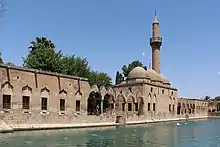
According to some Jewish and Muslim sources, Urfa is Ur Kasdim, the hometown of Abraham, the grandfather of Jacob whom God named Israel.[33] This identification was disputed by Leonard Woolley, the excavator of the Sumerian city of Ur in 1927 and scholars remain divided on the issue. Urfa is also one of several cities that have traditions associated with Job.
For the Armenians, Urfa is considered a holy place since it is believed that the Armenian alphabet was invented there.[34]
Politics
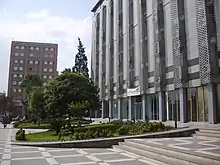
It is a stronghold of the governing Justice and Development Party. However, in the 2009 local elections, the city elected an independent, Ahmet Eşref Fakibaba, as mayor.[35]
Demographics
Demographic history
The ethnic demographics of the city have shifted over the centuries. In ancient times, the region was mixed with Greeks, Arabs, Syrians, and Armenians.[8] At the time of the First Crusade, the majority of the population were either Armenian or Syriac Christians. By the beginning of the 21st century Urfa had a very mixed population, ethnically and religiously. Upon the request of the Ministry of the Interior and Woodrow Wilson, in late 1918, the mutasarrifate of Urfa reported that there were roughly 33 thousand Turks, 27 thousand Kurds, 12 thousand Arabs, 5.5 thousand Armenians, 3 thousand Assyrians, and 5 hundred Jews in the central Urfa kaza (which also includes the settlements in vicinity of the city), totaling to almost 81 thousand people.[36] The Armenian and Assyrian Genocides, undertaken by Ottoman Government troops and Ottoman sponsored militias such as the special organisation,[37] led to the death or ethnic cleansing of much of the Christian population of Urfa and the surrounding region. Following the establishment of the Republic of Turkey, most of the remaining non-Muslim population left the city due to continued persecution.[38] Ely Bannister Soane wrote in 1910 that the majority of the population found in the streets, cafés, and corner loafers was composed of Turkish effendis, apart from which the town was also populated by Arabs, Kurds, and a large number of Armenians.[39] According to the report of the British forces in the region, the pre-war population of the city was mixed with Kurds and Turks with an additional Armenian community of 7,500 people.[40]
Language
In early 19th century, the dominant language of the city was reported to be Turkish, the only language heard in the bazaars,[41] while Hebrew, Armenian, Syriac, Kurdish, Arabic, and Persian were also noted to be spoken. Armenians were observed to speak Turkish to strangers, while Assyrians spoke Arabic.[8]
Cuisine
As the city of Urfa is deeply rooted in history, so its unique cuisine is an amalgamation of the cuisines of the many civilizations that have ruled in Urfa . It is widely believed that Urfa is the birthplace of many dishes, including Raw Kibbé (Çiğ Köfte), that according to the legend, was crafted by the Prophet Abraham from ingredients he had at hand.[45] The walnut-stuffed Turkish dessert crepe (called şıllık) is a regional specialty.[46]
Many vegetables are used in the Urfa cuisine, such as the "'Ecır," the "Kenger," and the "İsot", the legendary local red capsicum that is a smaller and darker cultivar of the Aleppo pepper that takes a purplish black hue when dried and cured.
Unlike most of the Turkish cities that use different versions of regular butter in their regional cuisine, Urfa is, together with Antep, Mardin and Siirt a big user of clarified butter, made exclusively from sheep's milk, called locally "Urfayağı" ("Urfabutter").
Transport
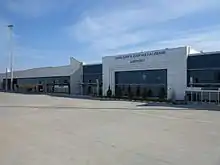
Şanlıurfa GAP Airport is located about 34 km (21 mi) northeast of the city and has direct flights to Istanbul, Ankara and Izmir. Construction of the first phase of a planned four-route, 78 km network of trolleybus lines began in late 2017,[47] and the first of 10 bi-articulated trolleybuses built by manufacturer Bozankaya was received in September 2018.[48] However, work on additional vehicles was suspended because of various problems,[49] and in 2020 the single vehicle delivered in 2018 remained the only trolleybus completed.[50] A revised date for the eventual opening of the first line has yet to be set.[50]
The main highway from Gaziantep to Diyarbakır now bypasses Urfa on the northwest.[10]: 8
Climate
Urfa has a hot-summer Mediterranean climate (Köppen: Csa, Trewartha: Cs). During the summer months, temperatures often exceed 40 °C (104 °F) while rainfall is almost non-existent. Winters are cool and relatively wet, frost is common along with very sporadic snowfall. Spring and autumn are warm and moderately dry.
| Climate data for Urfa (1991-2020, extremes 1929–2020) | |||||||||||||
|---|---|---|---|---|---|---|---|---|---|---|---|---|---|
| Month | Jan | Feb | Mar | Apr | May | Jun | Jul | Aug | Sep | Oct | Nov | Dec | Year |
| Record high °C (°F) | 21.6 (70.9) |
25.5 (77.9) |
29.5 (85.1) |
36.4 (97.5) |
40.3 (104.5) |
44.1 (111.4) |
46.8 (116.2) |
46.2 (115.2) |
43.9 (111.0) |
37.8 (100.0) |
30.8 (87.4) |
26.0 (78.8) |
46.8 (116.2) |
| Average high °C (°F) | 10.6 (51.1) |
12.5 (54.5) |
17.5 (63.5) |
23.1 (73.6) |
29.6 (85.3) |
35.7 (96.3) |
39.5 (103.1) |
39.0 (102.2) |
34.5 (94.1) |
27.7 (81.9) |
18.9 (66.0) |
12.4 (54.3) |
25.1 (77.2) |
| Daily mean °C (°F) | 6.2 (43.2) |
7.5 (45.5) |
11.8 (53.2) |
16.8 (62.2) |
22.8 (73.0) |
28.8 (83.8) |
32.6 (90.7) |
32.0 (89.6) |
27.4 (81.3) |
21.2 (70.2) |
13.1 (55.6) |
7.9 (46.2) |
19.0 (66.2) |
| Average low °C (°F) | 3.0 (37.4) |
3.6 (38.5) |
7.0 (44.6) |
11.3 (52.3) |
16.6 (61.9) |
21.9 (71.4) |
25.4 (77.7) |
25.0 (77.0) |
20.8 (69.4) |
15.8 (60.4) |
8.9 (48.0) |
4.8 (40.6) |
13.7 (56.7) |
| Record low °C (°F) | −10.6 (12.9) |
−12.4 (9.7) |
−7.3 (18.9) |
−3.2 (26.2) |
2.5 (36.5) |
8.3 (46.9) |
15.0 (59.0) |
16.0 (60.8) |
10.0 (50.0) |
1.9 (35.4) |
−6.0 (21.2) |
−6.4 (20.5) |
−12.4 (9.7) |
| Average precipitation mm (inches) | 81.0 (3.19) |
66.3 (2.61) |
57.9 (2.28) |
44.7 (1.76) |
26.2 (1.03) |
5.8 (0.23) |
2.0 (0.08) |
4.0 (0.16) |
8.1 (0.32) |
24.6 (0.97) |
51.2 (2.02) |
78.7 (3.10) |
450.5 (17.74) |
| Average rainy days | 11.73 | 10.40 | 10.27 | 9.40 | 7.77 | 1.77 | 0.43 | 0.33 | 1.47 | 5.73 | 7.17 | 10.87 | 77.3 |
| Average relative humidity (%) | 74 | 72 | 61 | 51 | 43 | 27 | 22 | 24 | 28 | 43 | 57 | 72 | 48 |
| Mean monthly sunshine hours | 117.8 | 135.6 | 189.1 | 225.0 | 288.3 | 345.0 | 359.6 | 325.5 | 276.0 | 220.1 | 159.0 | 108.5 | 2,749.5 |
| Mean daily sunshine hours | 3.8 | 4.8 | 6.1 | 7.5 | 9.3 | 11.5 | 11.6 | 10.5 | 9.2 | 7.1 | 5.3 | 3.5 | 7.5 |
| Source 1: Devlet Meteoroloji İşleri Genel Müdürlüğü[51] | |||||||||||||
| Source 2: Weatherbase[52] | |||||||||||||
Main sights
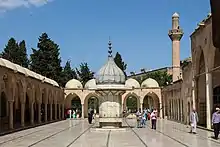
- Urfa castle – built in antiquity, the current walls were constructed by the Abbasids in 814 AD.
- The legendary Pool of Sacred Fish (Balıklıgöl) where Abraham was thrown into the fire by Nimrod. The pool is in the courtyard of the mosque of Halil-ur-Rahman, built by the Kurdish Ayyubids in 1211 and now surrounded by the attractive Gölbaşı-gardens designed by architect Merih Karaaslan. The courtyard is where the fishes thrive. A local legend says seeing a white fish will open the door to the heavens.
- Rızvaniye Mosque – a more recent (1716) Ottoman mosque, adjoining the Balıkligöl complex.
- 'Ayn Zelîha – A source nearby the historical center, named after Zulaykha, a follower of Abraham.
- The Great Mosque of Urfa was built in 1170, on the site of a Christian church the Arabs called the "Red Church," probably incorporating some Roman masonry. Contemporary tradition at the site identifies the well of the mosque as that into which the towel or burial cloth (mendil) of Jesus was thrown (see Image of Edessa and Shroud of Turin). In the south wall of the medrese adjoining the mosque is the fountain of Firuz Bey (1781).
- Ruins of the ancient city walls.
- Eight Turkish baths built in the Ottoman period.
- The traditional Urfa houses were split into sections for family (harem) and visitors (selâm). There is an example open to the public next to the post office in the district of Kara Meydan.
- The Temple of Nevali Çori – Neolithic settlement dating back to 8000BC, now buried under the Atatürk Reservoir, with some artefacts relocated above the waterline.
- Göbekli Tepe – The world's oldest known temple, dated 10th millennium BC (ca 11,500 years ago).[4]
The citadel
Urfa castle is located on the rocky heights south of the historical city center.[19]: 3 It is long and thin because it crowns a ridge.[10]: 8
Old city walls

The monumental walls surrounding the old town date from the Abbasid-era rebuilding in 812.[10]: 12 The only major repairs to them took place during the early Ottoman period, in 1660-61, when there was restoration work done on the city's fortifications in general.[10]: 12 The walls are made of large stone blocks over 30 cm tall all the way through (i.e. not just on the faces).[10]: 12 The early Ottoman repairs are distinguished by their small size, white color, and light bossing.[10]: 12 In many places, people have built private houses directly adjoining the city wall's inner face, so that it forms one side of the house.[10]: 12 Because of Urfa's location, the east wall was always the most exposed to attack; large chunks of the surviving sections here consist of Ottoman repairs.[10]: 14
Balıklıgöl
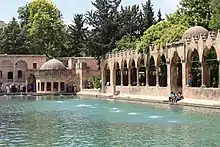
According to legend, Balıklıgöl was formed by the prophet Abraham's confrontation with the tyrant Nimrod, who supposedly ruled over Urfa from the citadel above.[7]: 138 When Abraham came of age, he destroyed Nimrod's idols, and in retaliation Nimrod "made a catapult out of the castle's twin pillars" and hurled Abraham into a pit of fire below.[7]: 138 When Abraham landed, the flames miraculously turned into water, and the wood used to stoke the fire was turned into carp.[7]: 138
The carp are now called kutsal balıklar, or "sacred fish", and the spring water is believed to have healing properties.[7]: 130 The fish are never to be eaten.[53]: 217
In ancient times, the pond and its carp were sacred to the fertility goddess Atargatis, or Tar'atha.[18]: 79–80 [53]: 217 With the shift in religion, the pond and its fish became associated with the prophet Abraham instead.[18]: 79–80 This pond is mentioned in the late-4th-century account of the Christian pilgrim Egeria, who spent three days at Edessa[18]: 80 and wrote that the fish were "shining and succulent".[53]: 217 According to Drijvers, a temple to Atargatis once stood in this area.[18]: 80
There was a major effort to renovate the Balıklıgöl complex in the 1990s and turn it into a cultural heritage site, clearing out "noisy vernacular elements" and making it into a tidy, organized space.[7]: 131, 9 Before, the complex was run-down and crowded in by makeshift houses, which the authorities considered "an eyesore and a safety hazard" and were expropriated and demolished.[7]: 139
Balıklıgöl is associated with folk religious practices which, in recent decades, have become somewhat controversial with Muslim revivalists who "insist that such things have no place in Islam".[7]: 130–1 For example, on Qadr Night (Kadır Gecesi), the night commemorating the first revelation of the Qur'an to Muhammad, tens of thousands of Muslims come to Balıklıgöl to "spend the night awake in communal worship".[7]: 130 This practice may have its origins in the Christian ritual of incubation that was practiced in Christian Edessa.[7]: 137 The city's mufti also brings out a glass case that supposedly contains Muhammad's beard (Sakal-ı Şerif), and people crowd around and try to touch or kiss it.[7]: 137 According to local tradition, spending Qadr Night at Balıklıgöl three years in a row is equivalent to one pilgrimage to Mecca - although such a claim tends to be frowned upon by Muslim clerics.[7]: 137
Gümrük Hanı
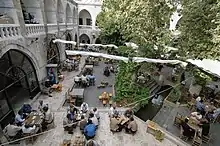
The Gümrük Hanı, or "customs caravanserai",[10]: 24 is located at the end of Divan Caddesi.[54] Variously dated to the late 16th century[5]: 620 [54] or the 18th or 19th centuries,[10]: 24 it is a two-story building arranged around "a more or less square courtyard".[10]: 24 The ground floor is occupied by shops opening up onto the courtyard.[10]: 24 Above the shops on the upper level is a portico with access to rooms now used as private apartments.[10]: 24–5 The shady courtyard is filled with tables belonging to teahouses and watch repairers.[54] Just next door to the Gümrük Hanı is a bedestan.[54]
Gallery
 Mevlid-i Halil Mosque, built next to the site where prophet Abraham is believed to have been born.
Mevlid-i Halil Mosque, built next to the site where prophet Abraham is believed to have been born. Şanlıurfa Museum
Şanlıurfa Museum Gölbaşı-Garden
Gölbaşı-Garden Ruins of Urfa castle
Ruins of Urfa castle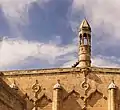 Urfa Armenian Protestant church
Urfa Armenian Protestant church Euphrates River
Euphrates River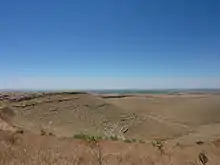 Surrounding fields of Göbekli Tepe, the site of the oldest temple in the world.[4]
Surrounding fields of Göbekli Tepe, the site of the oldest temple in the world.[4]
See also
- Cilicia War
- Urfa Resistance
- Chronology of the Turkish War of Independence
- Cities of the ancient Near East
- Haliliye
- Karaköprü
- Göbekli Tepe
References
- "'City of prophets' drawing faith tourists". Hürriyet Daily News. 20 November 2014. Retrieved 29 October 2020.
- "Area of regions (including lakes), km²". Regional Statistics Database. Turkish Statistical Institute. 2002. Retrieved 5 March 2013.
- "Turkey: Major cities and provinces". citypopulation.de. Retrieved 8 February 2015.
- "The World's First Temple - Archaeology Magazine Archive". archive.archaeology.org. Retrieved 22 March 2018.
- Miller, Julie A. (1995). "Şanlıurfa". In Ring, Trudy (ed.). International Dictionary of Historic Places, Vol. 3: Southern Europe. Chicago and London: Fitzroy Dearborn. pp. 617–20. ISBN 1-884964-02-8. Retrieved 3 October 2022.
- "The secret Jews of remote Turkey". Jewish Telegraph Agency. 4 March 2003. Retrieved 4 October 2022.
- Purcell, Bridget (2017). "Rebellious Matter". In Biehl, Joao; Locke, Peter (eds.). Unfinished: The Anthropology of Becoming. United States: Duke University Press. ISBN 9780822372455. Retrieved 4 October 2022.
- The Oriental Herald, and Journal of General Literature Vol. XII. London. 1827. pp. 39, 40, 47, 48. Retrieved 9 September 2022.
- Avcıkıran, Adem (2009). Kürtçe Anamnez Anamneza bi Kurmancî (in Turkish and Kurdish). p. 57.
- Sinclair, T. A. (1990). Eastern Turkey: An Architectural and Archaeological Survey, Volume IV. London: The Pindar Press. ISBN 0 907132 52 9. Retrieved 20 March 2022.
- Schnusenberg, Christine (2010). The Mythological Traditions of Liturgical Drama: The Eucharist as Theater. New York: Paulist Press. p. 116. ISBN 978-0-8091-0544-1.
- Murray, Alan V. (2006). The Crusades: An Encyclopedia. ABC-CLIO. p. 378. ISBN 978-1-57607-862-4.
- Segal, J. B. (2001) [1970]. "I. The Beginnings". Edessa:'The Blessed City' (2 ed.). Piscataway, New Jersey, United States: Gorgias Press. p. 5. ISBN 0-9713097-1-X.
It is certainly surprising that no obvious reference to Orhay has been found so far in the early historical texts dealing with the region, and that, unlike Harran, its name does not occur in cuneiform itineraries. This may be accidental, or Orhay may be alluded to under a different name which has not been identified. Perhaps it was not fortified, and therefore at this time a place of no great military significance. With the Seleucid period, however, we are on firm historical ground. Seleucus I founded—or rather re-founded—a number of cities in the region. Among them, probably in 303 or 302 BC, was Orhay.
- Renfrew, Colin; Boyd, Michael J.; Morley, Iain (2016). Death Rituals and Social Order in the Ancient World: Death Shall Have No Dominion. Cambridge University Press. p. 74. ISBN 9781107082731.
- "TOMBOLARE – Urfa Man / Balıklıgöl Statue, c. 10,000 BC". Tumblr. Retrieved 22 March 2018.
- Ball, Warwick (2000). "Edessa and the Coming of Christendom". Rome in the East: The Transformation of an Empire. London and New York: Routledge. pp. 87–96. ISBN 0-415-11376-8. Retrieved 4 November 2022.
- Lieu, Samuel (1997). "Edessa". Encyclopaedia Iranica. Vol. 8. pp. 174–175.
- Drijvers, H.J.W. (1980). Cults and Beliefs at Edessa. Leiden: E.J. Brill. ISBN 90-04-06050-2. Retrieved 2 November 2022.
- Tonghini, Cristina (2021). From Edessa to Urfa: The Fortification of the Citadel. Oxford: Archaeopress Publishing. ISBN 978-1-78969-757-5. Retrieved 1 October 2022.
- Honigmann, E.; Bosworth, C.E.; Faroqhi, Suraiya (1995). "AL-RUHĀ". In Bosworth, C.E.; Van Donzel, E.; Heinrichs, W.P.; Lecomte, G. (eds.). The Encyclopaedia of Islam, Volume VIII (NED-SAM). Leiden: E.J. Brill. pp. 586–7. ISBN 90 04 09834 8. Retrieved 27 October 2022.
- Gibb, Hamilton A. R. (1969). "Zengi and the Fall of Edessa". In Setton, Kenneth M.; Baldwin, Marshall W. (eds.). History of the Crusades, Volume I: The First Hundred Years (Second ed.). Madison, Milwaukee, and London: University of Wisconsin Press. pp. 449–64. ISBN 0-299-04834-9. Retrieved 29 September 2022.
- Amouroux-Mourad, Monique (1988). Le comté d'Edesse, 1098–1150. Paul Guethner.
- Baldwin, Marshall W. (1969) [1955]. "The Latin States under Baldwin III and Amalric I, 1143–1174". In Setton, Kenneth M.; Baldwin, Marshall W. (eds.). A History of the Crusades, Volume I: The First Hundred Years (Second ed.). Madison, Milwaukee, and London: University of Wisconsin Press. pp. 528–61. ISBN 0-299-04834-9.
- Nicholson, Robert Lawrence (1973). Joscelyn III and the Fall of the Crusader States, 1134–1199. Leiden: E. J. Brill.
- Runciman, Steven (1952). A History of the Crusades, Volume II: The Kingdom of Jerusalem and the Frankish East. Cambridge: Cambridge University Press.
- Shatzmiller, Maya (31 December 1993). Labour in the Medieval Islamic World. BRILL. ISBN 978-90-04-09896-1.
- Taş, Yasin (2019). Osmanlı döneminde Urfa’da sosyal hayat (mahkeme kayıtlarına göre 1850-1900) (in Turkish). Istanbul: Hiperlink Eğitim İletişim Yayıncılık. ISBN 978-605-281-528-1. Retrieved 3 October 2022.
- "Edessa". Jewish Encyclopedia. 1906.
- "Interview with Harun Bozo". The Library of Rescued Memories. Central Europe Center for Research and Documentation.
- Kinross, Lord (1977). The Ottoman Centuries, The Rise and Fall of the Turkish Empire. United States: Harper Perennial. pp. 560. ISBN 0-688-08093-6.
- Joseph, John (1983). Muslim-Christian Relations and Inter-Christian Rivalries in the Middle East: The Case of the Jacobites in an Age of Transition. United States: State University of New York Press. pp. 150. ISBN 0-87395-612-5.
- armenian-genocide.org
- "Ur Kasdim: Where is Abraham's Birthplace? - TheTorah.com". www.thetorah.com. Retrieved 10 March 2021.
- Öktem, Kerem (2003). Creating the Turk's Homeland: Modernization, Nationalism and Geography in Southeast Turkey in the late 19th and 20th Centuries (PDF). Harvard: University of Oxford, School of Geography and the Environment, Mansfield Road, Oxford, OX1 3TB, UK. Archived from the original (PDF) on 9 November 2013. Retrieved 19 January 2013.
For Armenians, the city has a great symbolic value, as the Armenian alphabet was invented there, thanks to a group of scholars and clergy headed by Mesrop Mashtots in the 5th century
- "Kurds in Southeast Anatolia celebrate DTP's boost in votes". Today's Zaman. 31 March 2009. Archived from the original on 8 April 2014. Retrieved 7 February 2013.
- Aslan, Ahmet. "URFA'DA ASAYİŞ VE GÜVENLİK (1913-1918)" (PDF). İstanbul Üniversitesi. Retrieved 7 June 2022.
- Bloxham, Donald (2003). "The Armenian Genocide of 1915–1916: Cumulative Radicalization and the Development of a Destruction Policy". Past & Present. 181 (181): 141–191.
- Biner, Zerrin Özlem (2019), p371. States of Dispossession: Violence and Precarious Coexistence in Southeast Turkey
- Soane, Ely Bannister (1910). To Mesopotamia and Kurdistan in Disguise. pp. 46–47.
- Military Report on Mesopotamia (Iraq). p. 17. Retrieved 28 October 2022.
- London Magazine, Volume 7. London. 1827. p. 546. Retrieved 9 September 2022.
- Çınar (2019). The Decline of Democracy in Turkey: A Comparative Study of Hegemonic Party Rule. Routledge. p. 102. ISBN 9780367729233.
- Muslu, Olcay (2022). "UNESCO-Based and UNESCO-Free: Governmental and Non-Governmental Efforts for Safeguarding Intangible Cultural Heritage in Turkey". In Schippers, Huib; Seeger, Anthony (eds.). Music, Communities, Sustainability: Developing Policies and Practices. Oxford University Press. p. 124.
- Yavuz, M. Hakan (28 August 2003). Islamic Political Identity in Turkey. Oxford University Press. p. 157. ISBN 978-0-19-534770-8. Retrieved 28 October 2022.
- From Kâtib el Bağdadî in p.196Urfa'da Pişer Bize de Düşer, Halil & Munise Yetkin Soran, Alfa Yayın, 2009, Istanbul ISBN 978-605-106-065-1
- "Şanlıurfa'nın 'şıllık' tatlısı tescillendi". Sabah. Retrieved 8 November 2018.
- "Trolleynews [regular news section]". Trolleybus Magazine. Vol. 54, no. 340. UK: National Trolleybus Association. July–August 2018. p. 155. ISSN 0266-7452. OCLC 62554332.
- "Trolleynews". Trolleybus Magazine. Vol. 55, no. 343. UK: National Trolleybus Association. January–February 2019. p. 38. ISSN 0266-7452.
- "Trolleynews". Trolleybus Magazine. Vol. 55, no. 344. UK: National Trolleybus Association. March–April 2019. p. 75. ISSN 0266-7452.
- "Trolleynews". Trolleybus Magazine. Vol. 56, no. 349. UK: National Trolleybus Association. January–February 2020. p. 35. ISSN 0266-7452. OCLC 62554332.
- "Resmi İstatistikler: İllerimize Ait Mevism Normalleri (1991–2020)" (in Turkish). Turkish State Meteorological Service. Retrieved 7 August 2021.
- "Urfa, Turkey Travel Weather Averages (Weatherbase)".
- Segal, J.B. (1963). "The Sabian Mysteries: The Planet Cult of Harran". Vanished Civilizations. New York. pp. 202–20.
- Ayliffe, Rosie; Dubin, Marc; Gawthrop, John; Richardson, Terry (2010). The Rough Guide to Turkey (Digital ed.). Rough Guides Limited. ISBN 9781848368460. Retrieved 3 October 2022.
